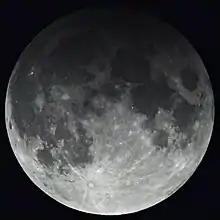| Partial lunar eclipse 2008/8/16 | |
|---|---|
| Saros (member) | 138 (29) |
| Recent | <S <T < > T> S> |
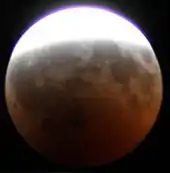 Cape Town, South Africa | |
 The Moon passes right to left through the Earth's northern shadow | |
| Gamma[1] | 0.5647 |
| Duration (hr:mn:sc) | |
| Partial | 3:08:08 |
| Penumbral | 5:30:31 |
| Contacts | |
| P1 | 18:24:50 UTC |
| U1 | 19:36:05 UTC |
| Greatest | 21:10:06 UTC |
| U4 | 22:44:13 UTC |
| P4 | 23:55:21 UTC |
 At ascending node in Capricornus | |
A partial lunar eclipse took place on 16 August 2008, the second of two lunar eclipses in 2008, with the first being a total eclipse on 20 February 2008. The next lunar eclipse was a penumbral eclipse occurring on 9 February 2009, while the next total lunar eclipse occurred on 21 December 2010.
The Moon's apparent diameter was 26.2 arcseconds smaller than the 21 February 2008 total lunar eclipse.
Eclipse season
This is the second eclipse this season.
First eclipse this season: 1 August 2008 Total Solar Eclipse
Viewing
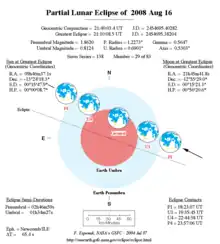
 These simulated views of the earth from the center of the moon during the lunar eclipse show where the eclipse is visible on earth. |
Parts of Australia saw it begin before sunrise, while parts of South America saw it end just after sunset. The eclipse is also seen in the Philippines and other parts of Asia at moonset. Parts of Europe, the Middle East and Africa saw it when it is visible.
The penumbral eclipse began at 18:23 UTC, with the partial eclipse beginning at 19:36. The time of greatest eclipse was 21:10. The partial eclipse ended at 22:44, and the penumbral eclipse will ended at 23:57.
The planet Neptune was 2 days past opposition, visible in binoculars as an 8th magnitude "star" just two degrees west and slightly south of the Moon.
Map
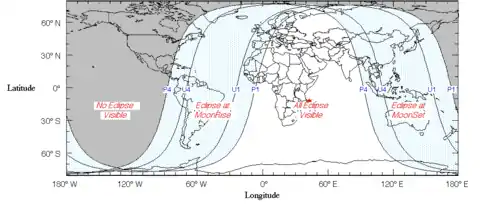
Relation to other lunar eclipses
Eclipses of 2008
- An annular solar eclipse on 7 February.
- A total lunar eclipse on 21 February.
- A total solar eclipse on 1 August.
- A partial lunar eclipse on 16 August.
Lunar year series
| Lunar eclipse series sets from 2006–2009 | ||||||||
|---|---|---|---|---|---|---|---|---|
| Descending node | Ascending node | |||||||
| Saros # and photo |
Date Viewing |
Type Chart |
Gamma | Saros # and photo |
Date Viewing |
Type Chart |
Gamma | |
113.jpg.webp) |
2006 Mar 14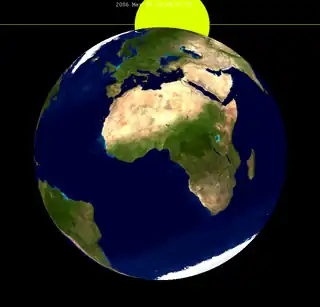 |
penumbral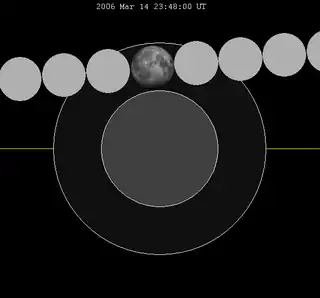 |
1.0211 | 118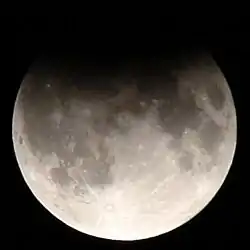 |
2006 Sep 7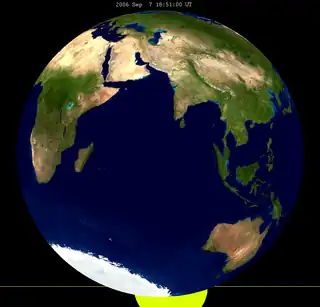 |
partial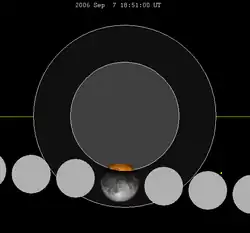 |
−0.9262 | |
123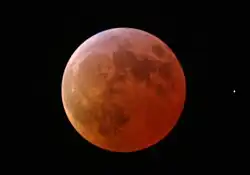 |
2007 Mar 03 |
total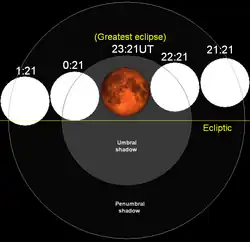 |
0.3175 | 128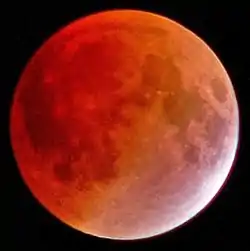 |
2007 Aug 28 |
total |
−0.2146 | |
133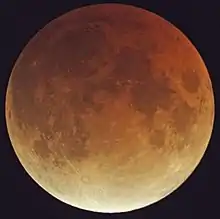 |
2008 Feb 21 |
total |
−0.3992 | 138 |
2008 Aug 16 |
partial |
0.5646 | |
143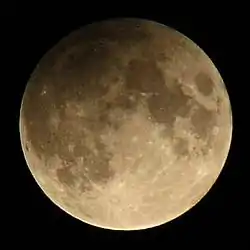 |
2009 Feb 09 |
penumbral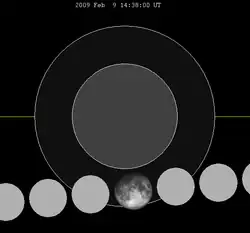 |
−1.0640 | 148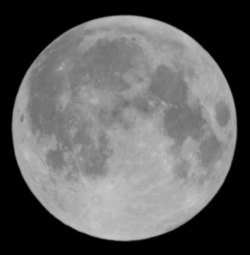 |
2009 Aug 06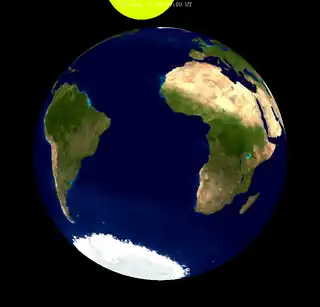 |
penumbral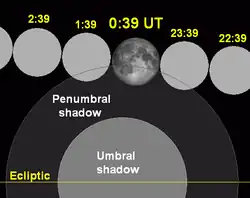 |
1.3572 | |
| Last set | 2005 Apr 24 | Last set | 2005 Oct 17 | |||||
| Next set | 2009 Dec 31 | Next set | 2009 Jul 07 | |||||
Saros series
Lunar saros series 138 has 26 total eclipses between September 7, 2044 and March 24, 2369. The longest eclipse will be on January 7, 2243, and last for 102 minutes.
Partial eclipses will occur between June 24, 1918 and August 13, 2603. Penumbral eclipses will occur between October 15, 1521 and March 30, 2982. [2]
Metonic cycle (19 years)
The Metonic cycle repeats nearly exactly every 19 years and represents a Saros cycle plus one lunar year. Because it occurs on the same calendar date, the Earth's shadow will in nearly the same location relative to the background stars.
| Descending node | Ascending node | |||||
|---|---|---|---|---|---|---|
| Saros | Date | Type | Saros | Date | Type | |
| 103 | 1951 Feb 21.88 | Penumbral | 108 | 1951 Aug 17.13 | Penumbral | |
 |
 | |||||
| 113 | 1970 Feb 21.35 | Partial | 118 | 1970 Aug 17.14 | Partial | |
 |
 | |||||
| 123 | 1989 Feb 20.64 | Total | 128 | 1989 Aug 17.13 | Total | |
 |
 | |||||
| 133 | 2008 Feb 21.14 | Total | 138 | 2008 Aug 16.88 | Partial | |
 |
 | |||||
| 143 | 2027 Feb 20.96 | Penumbral | 148 | 2027 Aug 17.30 | Penumbral | |
 |
 | |||||
Half-Saros cycle
A lunar eclipse will be preceded and followed by solar eclipses by 9 years and 5.5 days (a half saros).[3] This lunar eclipse is related to two total solar eclipses of Solar Saros 145.
| 11 August 1999 | 21 August 2017 |
|---|---|
 |
 |
Photo

Progression from Oslo, Norway
.jpg.webp) Brighton, Queensland, 20:03 UTC
Brighton, Queensland, 20:03 UTC Ruzsky District, Russia, 20:21 UTC
Ruzsky District, Russia, 20:21 UTC.jpg.webp) Palinuro, Italy, 20:31 UTC
Palinuro, Italy, 20:31 UTC Tel Aviv, Israel, 20:43 UTC
Tel Aviv, Israel, 20:43 UTC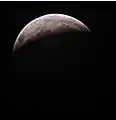 Groningen, Netherlands, 20:50 UTC
Groningen, Netherlands, 20:50 UTC Madrid, Spain, 20:53 UTC
Madrid, Spain, 20:53 UTC.jpg.webp) Jaguariúna, Brazil, 21:00 UTC
Jaguariúna, Brazil, 21:00 UTC_(1).jpg.webp) Zürich, Switzerland, 21:06 UTC
Zürich, Switzerland, 21:06 UTC Toulouse, France, 21:07 UTC
Toulouse, France, 21:07 UTC Solna, Sweden, 21:09 UTC
Solna, Sweden, 21:09 UTC.jpg.webp) Boralesgamuwa, Sri Lanka, 21:12 UTC
Boralesgamuwa, Sri Lanka, 21:12 UTC.jpg.webp) Johor Bahru, Malaysia, 21:15 UTC
Johor Bahru, Malaysia, 21:15 UTC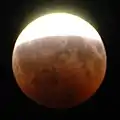 Langenbernsdorf, Germany, 21:23 UTC
Langenbernsdorf, Germany, 21:23 UTC Bucharest, Romania, 21:27 UTC
Bucharest, Romania, 21:27 UTC.jpg.webp) Rozbórz Długi, Poland, 21:45 UTC
Rozbórz Długi, Poland, 21:45 UTC.jpg.webp) Nasr City, Egypt, 22:12 UTC
Nasr City, Egypt, 22:12 UTC
See also
- List of lunar eclipses and List of 21st-century lunar eclipses
- Solar eclipse of August 1, 2008
- File:2008-08-16 Lunar Eclipse Sketch.gif Chart
Notes
- ↑ Gamma is the minimum distance of the Moon's shadow axis from Earth's centre in Earth radii at greatest eclipse.
- ↑ Hermit Eclipse: Eclipse Saros 138
- ↑ Mathematical Astronomy Morsels, Jean Meeus, p.110, Chapter 18, The half-saros
External links
- NASA: Partial Lunar Eclipse: August 16, 2008
- NASA
- 2008 Aug 16 chart: Eclipse Predictions by Fred Espenak, NASA/GSFC
- Hermit eclipse (Ian Cameron Smith) Partial Lunar Eclipse: August 16, 2008
- Sky&Telescope, Eclipses of 2008
- Animation of lunar eclipse 16 August 2008
- APOD August 20, 2008,
- Composite photos showing Earth's shadow
- Spaceweather.com lunar eclipse gallery
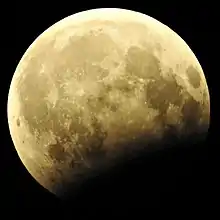
_(cropped).jpg.webp)
